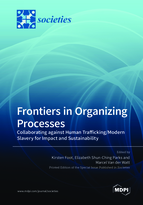Frontiers in Organizing Processes: Collaborating against Human Trafficking/Modern Slavery for Impact and Sustainability
A special issue of Societies (ISSN 2075-4698).
Deadline for manuscript submissions: closed (30 November 2022) | Viewed by 27050
Special Issue Editors
Interests: interorganizational and multisector collaboration; communicative organizing processes; social movements; qualitative methodology; human trafficking
Interests: listening and dialogue; diversity and difference; relational and community health and well-being
Special Issue Information
Dear Colleagues,
As the crime of human trafficking/modern slavery is multifaceted, collaborating to counter it across sectors, disciplines, regions, and from local to international levels is widely understood to be of utmost importance. However, the processes of organizing and leading robust collaborations are complex and challenging, and to be sustainable, such processes must result in both positive outcomes for the collaborating partners and demonstrable progress toward countering human trafficking. Despite a growing body of published research on anti-trafficking collaboration, many aspects of it remain understudied. This Special Issue of Societies invites researchers and collaboration leaders in the anti-trafficking arena to share research findings and/or evidence-supported practices on how to catalyze and support collaborations to generate and sustain track records of constructive impacts.
Submissions on any aspect(s) of collaboration processes that counter any type of human trafficking are welcome; research findings and evidence-supported practices pertaining to multisector collaboration are of particular interest. Potential subtopics for submissions to this Special Issue on countering human trafficking through collaboration include but are not limited to:
- Organizing and leading collaboration
- Survivor-involvement in collaborative efforts
- Trauma-informed collaboration
- Diversity, equity, inclusion and access issues within collaborative relationships
- The use of digital technologies to support collaboration
- Managing individual turnover and interpersonal dynamics in interorganizational relationships
- Trust-building within collaborations
- Ways to mitigate the risks and costs of collaboration
- Collaboration to counter criminal networks
- Managing collaborations across jurisdictions or policy frameworks
- Monitoring and evaluating the impacts of collaborative efforts
- Funding collaborative efforts
- Developing and employing collaboration agreements and coordination protocols
- Communication challenges
- Collaborative strategic planning
- Multi-level collaboration
- Sustaining collaborations
This Special Issue aims to publish articles that will be of interest to researchers; collaboration developers, leaders, and funders; policy makers; and anti-trafficking professionals in every sector and discipline. Contributions must address the topic of the Special Issue and fit in one of the three genres of papers published in this journal, i.e., research articles, literature reviews, or conceptual papers.
Dr. Kirsten Foot
Dr. Elizabeth Shun-Ching Parks
Dr. Marcel Van der Watt
Guest Editors
Manuscript Submission Information
Manuscripts should be submitted online at www.mdpi.com by registering and logging in to this website. Once you are registered, click here to go to the submission form. Manuscripts can be submitted until the deadline. All submissions that pass pre-check are peer-reviewed. Accepted papers will be published continuously in the journal (as soon as accepted) and will be listed together on the special issue website. Research articles, review articles as well as conceptual papers are invited. For planned papers, a title and short abstract (about 100 words) can be sent to the Editorial Office for announcement on this website.
Submitted manuscripts should not have been published previously, nor be under consideration for publication elsewhere (except conference proceedings papers). All manuscripts are thoroughly refereed through a double-blind peer-review process. A guide for authors and other relevant information for submission of manuscripts is available on the Instructions for Authors page. Societies is an international peer-reviewed open access monthly journal published by MDPI.
Please visit the Instructions for Authors page before submitting a manuscript. The Article Processing Charge (APC) for publication in this open access journal is 1400 CHF (Swiss Francs). Submitted papers should be well formatted and use good English. Authors may use MDPI's English editing service prior to publication or during author revisions.
Keywords
- human trafficking
- modern slavery
- anti-trafficking
- organized crime
- trauma-informed
- cross-sector partnership
- multisector collaboration
- coalitions








